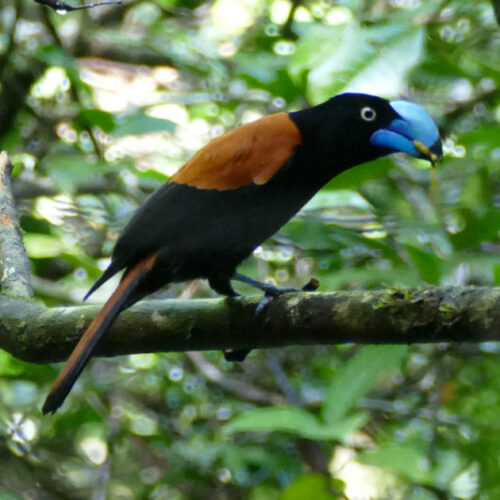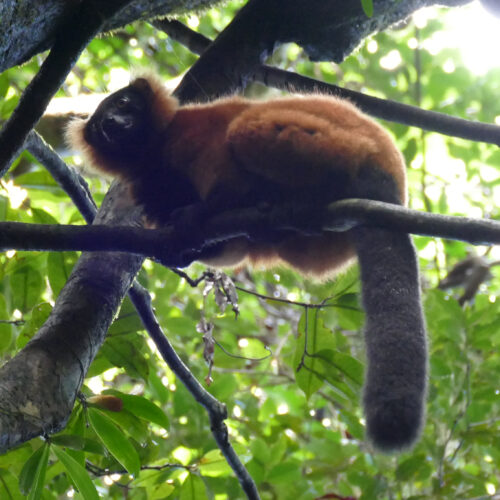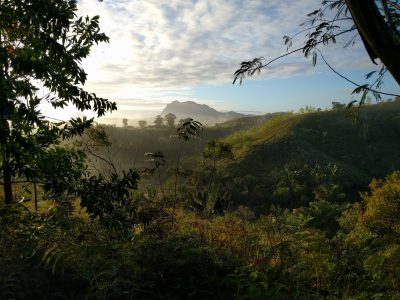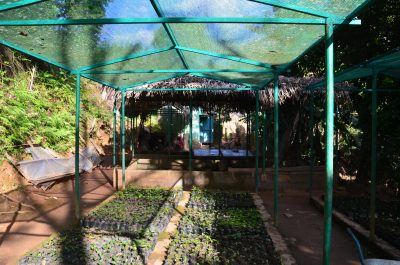What animal looks like it has the ears of a bat, teeth of a rodent, and an impressive middle finger to boot? If you answered the aye-aye, you would be correct!
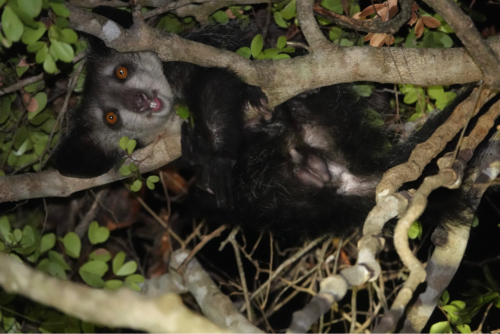
About Aye-ayes
Endemic to Madagascar, aye-ayes are the world’s largest nocturnal primate. With their large ears, penetrating eyes, and uniquely ever-growing incisors, they have a look unparalleled among other lemur species. Aye-ayes are active at night, when they forage for food with the help of their long and thin middle fingers. They use them to tap on trees and sense acoustic vibrations to locate and then extract insects from inside (they find wood-boring beetle larvae particularly tasty).
Aye-ayes are thought to inhabit more types of environments than any other lemur, but their nocturnal nature makes them hard to spot. They are found in primary rainforests, deciduous forests, mangrove swamps, and other habitats throughout Madagascar, but are thought to mostly inhabit the eastern coast and northwest.
Where can you see Aye-ayes in the wild in Madagascar?
We’ve compiled this guide on the best places to spot aye-ayes in the wild. Nothing is ever guaranteed with nature, but we hope this gives you the best chance to be able to spot one (or more!) of these amazing and unusual lemurs. Know another great spot to see aye-ayes? Let us know!
- Farainkaraina Forest (Northeastern Madagascar)
- Masoala National Park (Northeastern Madagascar)
- Daraina (Northeastern Madagascar)
- Kianjavato (Eastern Madagascar)
Farankaraina Forest (Northeastern Madagascar)
What to see
Containing both primary and secondary rainforests, Farankaraina Forest is thought to contain a high degree of Madagascar’s biodiversity. In addition to aye-ayes, you may spot the (also nocturnal) mouse lemur and white fronted brown lemurs. Other animals, such as the tailless tenrec, endemic tree rat, mantella frog, pygmy kingfisher, and crested ibis may also make an appearance during your hike along the park’s several trails.
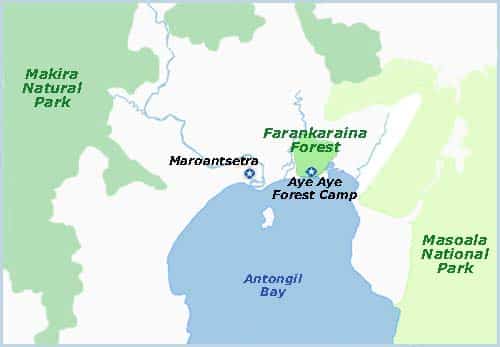
If you’re hoping to see aye-ayes, it is best to consider the time of year of your trip given that they feed on certain trees. According to the Aye-Aye Forest Camp, April and May may be particularly good months to spot lemurs, while the winter months (June to August) can sometimes be quieter as there is less food. You also may want to contact Farankaraina Forest staff before you arrive so they can start looking for aye-ayes.
Where to stay
Situated on Antongil Bay, Farankaraina Forest has access to both the forest and beaches. Lodging at the Aye-Aye Forest Camp consists of limited simple cabins right on the beach. Electricity is unreliable and we recommend bringing your own food as there is a kitchen with staff.
If you would like to learn more about Farankaraina, our featured artist for World Lemur Day 2024, Jessie Jordan, has been living in Madagascar since 2019. She traveled to Farankaraina in search of aye-ayes and shared her journey on YouTube (spoiler alert: she didn’t spot any aye-ayes on this trip, but she did see a lot of beautiful wildlife!).
Masoala National Park and Surrounding Lodges (Northeastern Madagascar)
Heading across Antongil Bay, Masoala National Park is one of the largest protected areas in Madagascar. The name Masoala actually translates to “eyes of the forest” in reference to the aye-ayes that inhabit the area. Mammal watcher Ian Thompson managed to spot an aye-aye in Farankaina, as well as across the bay at Dounia Forest Lodge in Masoala. Read the details of his trip here.
What to see
Masoala has a range of terrains, including its primary tropical rainforest, coastal forest, flooded forest, marsh, and mangrove. More than 15 species of lemur have been spotted in the park, including the red ruffed lemur, Masoala fork-marked lemur, and of course, the aye-aye.
Be aware that there may be certain rules at Masoala National Park itself regarding night walks, which have been prohibited recently to help protect the aye-aye’s status.
Some lodging options, like Masoala Forest Lodge, have small private forest reserves that allow night walks for guests. Jessie Jordan was fortunate enough to spot aye-ayes multiple times around Masoala Forest Lodge in the summer and fall of 2023 and 2024. She even caught one on video searching for food! Check out the Masoala Forest Lodge’s Instagram for more photos and videos.
Other animals you may see include one of the many species of butterflies, tropical birds, geckos, chameleons, and humpback whales off the coast if you visit between July and early September. Sea turtles and dugongs are also known to frequent the waters.
Where to stay
Getting to Masoala is an adventure in itself. It is most easily accessible by boat from Maroantsetra. Options for lodging include Masoala Forest Lodge, Dounia Forest Lodge, and Chez Arol Ecolodge, all of which offer meals. Masoala Forest Lodge can also accommodate vegan guests with advanced notice. When LCN’s Director, Lynne, visited the lodge for 5 days in the summer of 2023, she was impressed with the delicious multi-course vegan meals they prepared for her and her husband.
Daraina Forest (Northeastern Madagascar)
In northern Madagascar lies the town of Daraina. On the outskirts of Daraina lies the Loky-Manambato Protected Area, run by the Malagasy NGO Fanamby. While this area is well known for its population of Golden-crowned sifaka (aka Tattersall’s sifaka), it is also one of the best places to see an Aye-aye in the wild.
This video on Mammal Watching’s YouTube channel shows a (very fastidious!) aye-aye in Daraina:
Mammal watcher Cheryl Antonucci shares her trip to Daraina, where she saw aye-ayes two nights in a row!
Unlike watching them in a rainforest setting where the canopy is high and lighting for viewing and photography is difficult, this population is in the dry forest. This means the canopy is lower and more open. The Aye-ayes here are also not fed and there are no radio collated individuals currently.
Like in all areas, Aye-ayes sleep in nests during the day. Local trackers stake out active nests, then are able to take tourists to them. In October of 2023, three nests were staked out, all with adult male Aye-ayes. Over a two night period I was able to see two of them!
A typical night involves driving on dirt roads into the protected area to the forest’s edge. You then walk on mainly flat paths to the nest, and wait, then wait some more. I had the fortune of using a heat scope and was able to see my first Aye-aye still relaxing in his nest, laying on his back, not bothered by the excited voices of myself and friends when we came upon the nest. We waited patiently until darkness until all of a sudden the Aye-Aye was sitting next to his nest staring at us. He then took his time scratching and grooming himself for an extended period of time. After the grooming session, he started foraging in the trees above us. We were able to watch him use his elongated middle finger to tap at trees until he found an insect, then use his rodent like teeth to pull back the wood to eat his prize. In all we watched the first Aye-aye above us for over an hour until he went off deeper into the forest.
The second Aye-aye (which we saw on the second night) was more interested in eating than grooming, so the views were not as prolonged, as he quickly jumped from tree to tree.
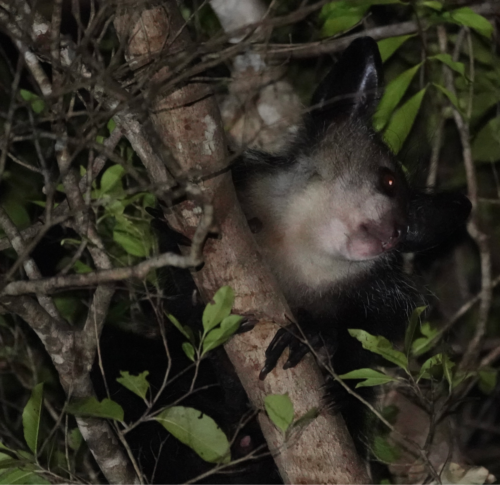
Cheryl describes the Daraina area:
While this area is a “gold mine” for lemur watching, it also is in an area with a lot of gold itself. Miners dig holes into the earth looking for gold, then leave the holes when they are done. Unlike other areas of Madagascar the miners are not cutting down the trees as we were told they like them for the shade. Both Aye-ayes I saw were in active gold areas, so while I had to look up to see the lemur, I also had to look down to not fall into a hole! The night of the second Aye-aye, many of the gold miners watched with us, and seemed just as excited to watch as we were.
Seeing wild Aye-ayes was one of my favorite wildlife experiences overall!
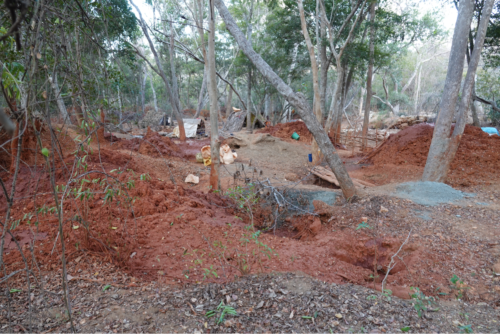
Kianjavato (Eastern Madagascar)
Moving further south, Kianjavato is made up of about a dozen villages and surrounding lowland evergreen rainforest fragments. It is located about a 2 hour drive east of Ranomafana National Park. It could easily be added to any trip down the RN7 that includes Ranomafana. LCN’s Director Lynne Venart visited this area in 2016 to tour the Madagascar Biodiversity Partnership’s field station there, and wrote a fantastic blog post about her experience. Also see mammal watcher Ian Thompson’s post on spotting aye-ayes in Kianjavato.
What to see
Nine different species of lemur can easily be seen in Kianjavato, including the Black-and-white ruffed lemur and Greater bamboo lemur. The endangered Jolly’s mouse lemur can only be found in this area and nearby Mananjary. Because Madagascar Biodiversity Partnership has radio collared several aye-ayes here for monitoring, visitors have great luck viewing aye-ayes!
The Madagascar Biodiversity Partnership (MBP) has been working on a reforestation project in Kianjavato since 2010. Through research, planning, and monitoring, they hope to create a lemur-friendly forest with native trees. As Lynne’s post outlines, community engagement is a key component to their project, with MBP engaging local farmers and other stakeholders and providing jobs and conservation “credits.” Lemur monitoring programs have been established for several species (including the aye-aye), helping to promote ecotourism in the area.
Where to stay
There is limited tourist infrastructure in Kianjavato. MBP has built a number of bungalows available for rent, and has been working on building up the infrastructure further.
Summary
Whether you have a trip to Madagascar already planned or are considering a trek there in the future, we hope this guide has provided some helpful insight on how to spot the elusive aye-aye in the wild! It’s important to remember to practice safe and respectful ecotourism that considers both the nature and people of this wonderfully biodiverse island. This aye-aye guide wouldn’t have been possible without the contributions from our wonderful LCN community, including Jessie Jordan, Lynne Venart, the Masoala Forest Lodge, and Mammal Watching. Thank you for having such a good “aye” and sharing your experiences, tips, and tricks for spotting them with us!

